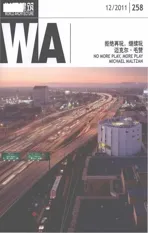内城艺术学院,洛杉矶,美国
2011-07-30MICHAEL,MALTZAN,ARCHITECTURE

1 鸟瞰/Aerial view(摄影/Photo: Iwan Baan)

2 阶段图示/Phase diagram
内城艺术学院位于洛杉矶市中心。该学院每年给1万个处于危难状况的青年提供艺术教育。那些青年来自洛杉矶公共学校。建筑位于贫民区的边缘,校园中有很多艺术设施,是城市里的一片绿洲。该学院是在15年内分3个建设阶段建成的,占地0.4hm2。设计概念是以现代化户外村庄作为设想,创建艺术机构对现代化和革新的认识。
城市里的一片绿洲
学院的设计透过多元化和交织的形式体现出校园设计的实体和功能元素的互相影响。功能空间通过一个广场和庭院的网络相互连接,模糊了室内外的界限。建筑包含一个99座的实验型剧院、教师办公室、制陶艺术工作室、动画片绘制工作室和大型多用途教室,这些空间同特定功能空间同等重要,促进了联系、交流和探索。
临街整洁的白色墙壁用来保护艺术领地,与周围的环境形成对比。该学院的安全度很高,但没有与贫民区隔离。外墙的偏转使学生们去注意和体会城市的复杂性。庭院和工作室的形式、灯光、颜色能激发学生们的灵感。位于学院中心的陶瓷塔象征着学生、社区和世界的联系。
艺术、表演和公共领域
该村庄模式提倡学生们之间的互动,同时也加强了学生对社会责任的了解和认知。孩子们可以在学院中心的大型公共场所展示个人创作,包括陶器、舞蹈、绘画、雕塑和动画。对建筑空间微妙的改变可以实现以上设想。在北面,陶瓷塔可以让学生在一个橙色的室内空间探索光和色彩的微妙。在庭院的对面,画廊上的一个停车坡道可以展示出学生的作品。在剧院向西的屋顶开了一个天窗,使舞台与自然世界能够进行对话。能卷起的大门、枢轴的分隔、遮光物和其他简单的元素,创造出了适合多种功能的灵活空间。
建立一个新的文化中心
第一阶段完成于1995年,包括929m2的工作室和围绕学校中心室外庭院的辅助空间。该中心集合空间可以是老师们工作的地方,也可以是路人的休息站。第二阶段完成于2003年,添加了大型工作室、厨房、木材店和动画工作室。第三阶段(校园扩建的最后阶段)完成于2008年的秋天,添加了2 137m2的空间,包括实验式剧院、视觉艺术楼、艺术表演工作室、学生/家长资源中心、花园和集合空间。□

3 外景/Exterior view(摄影/Photo: Iwan Baan)
The Inner-City Arts campus in downtown Los Angeles provides arts education for over 10,000 at-risk youth from LA public schools each year.Located on the edge of the Skid Row, the campus houses a range of art facilities and is an oasis in the urban environment. Built in three phases over 15 years, the one acre campus was conceived as a contemporary open air village designed with the contemporary and progressive sensibilities of the founding arts organization in mind.
A Community Oasis in The City
An aggregate of diverse, interwoven forms, the campus design highlights the interplay of physical and programmatic elements. Arrayed across the grounds, program spaces interconnect around a network of plazas and courtyards, blurring the threshold between interior and exterior. Just as important as the specific program spaces-a 99-seat black box theater, faculty offices, ceramics studios, animation studios, and larger multipurpose rooms-are the ways in which these spaces facilitate connection, dialogue and exploration.
At the street, taut white walls protect the arts enclave and rise in contrast to the surrounding
neighborhood sprawl. The campus is secured, but not isolated, from its Skid Row context. Deflections in the exterior surface open, inviting the students to acknowledge and engage the complexities of the city. Within, the courtyard and the studios weave together a composition of form, light, color and learning to inspire the students. The ceramics tower at the heart of the campus is a symbol of the connections forged between students, the community and the world at large.

5 一层平面/First floor plan 1-办公/Office 1a-上到办公室/Up to Offices 2-高侧窗/Clerestory Windows 3-卫生间/Restroom 4-储藏间/Storage 5-复印室/Copy 6-门厅/Lobby 7-资源中心/Resource Center 8-教室/Classroom 9-制陶教室/Ceramics Classroom 10-烧窑院/Kiln Yard 11-设备用房/Mechanical Room 12-电梯用房/Elevator Room 13-餐具室/Pantry 14-电力用房/Electrical Room 15-衣帽间/Locker Room 16-演员休息室/Greenroom 17-工作室/Workshop 18-后台走廊/Backstage Hallway 19-剧院/表演艺术教室/Theater/Performing Arts Classroom 20-通向屋顶停车场的坡道/Ramp to Rooftop Parking

6 二层平面/Second floor plan 1-办公/Office 2-储藏间/Storage 3-通向屋顶停车场的坡道/Ramp to Rooftop Parking 4-高侧窗/Clerestory Windows 5-控制台/Control Booth 6-走廊/Corridor 7-屋顶停车/Rooftop Parking 8-上空/Open to Below
Art, Performance, and The Public Realm
The village model supports the dynamic relationship between the individual students and their broader social responsibility. Children create works in ceramics, dance, painting, sculpture, or animation, and the products of their exploration are shared and expounded in the larger, more public spaces at the campus’ center. The subtle inflections of the architectural spaces both host and provoke this exchange. On its north face, the ceramics tower gives way to an orange inner-volume inviting students to explore light and color. Across the courtyard, a parking ramp slices over a gallery to expose the vibrant spectrum of student work. In the theater, a large skylight opens to the western sky, welcoming the natural world into dialogue with the stage. Large roll-up doors, pivoting partitions,black-out shades, and other simple features create programmatic and functional flexibility to allow multiple uses for these spaces.
Creating A New Center for Culture
Phase I, completed in 1995, includes 10,000sf of studio and support space surrounding the school's central outdoor courtyard. This central gathering space is both a retreat from the street beyond as well as a working space for the facility. Phase II,completed in 2003, added larger studio spaces, a kitchen, a wood shop, and animation studios. Phase III, the final phase of the campus expansion, was completed in the Fall 2008. The 23,000sf addition includes a black box theater, visual arts complex,performing arts studios, parent-teacher resource center, gardens and gathering spaces.□

7 外景/Exterior view(摄影/Photo: Iwan Baan)

8 外景/Exterior view(摄影/Photo: Iwan Baan)

9 内景/Interior view(摄影/Photo: Iwan Baan)

10 内景/Interior view(摄影/Photo: Iwan Baan)

11 剖面,表演艺术楼/Section, performing arts building 1-表演艺术楼屋顶/Performing Arts Building Roof 2-天窗/Skylight 3-室外停车平台/Exterior Parking Deck 4-后台走廊/Backstage Hallway 5-剧院空间/表演艺术教室/Theater Space/Performing Arts Classroom 6-后部室外入口/Exterior Entry Gate Beyond 7-夹层/Mezzanine
类型/Type: 艺术学校/ School for arts
面积/Size: 3 437m2/37 000 sf
造价/Cost: $9.2 M
状态/Status: 第一阶段完成于1995年,第二阶段完成于2003年,第三阶段完成于2008年/Phase I to completed 2014, phase II completed 2003, phase III completed 2008

12 内景/Interior view(摄影/Photo: Iwan Baan)

13 从庭院看西南立面/Southwest elevation from courtyard

14 从科勒街看东北立面/Northeast elevation from Kohler

15 剖面/Section
